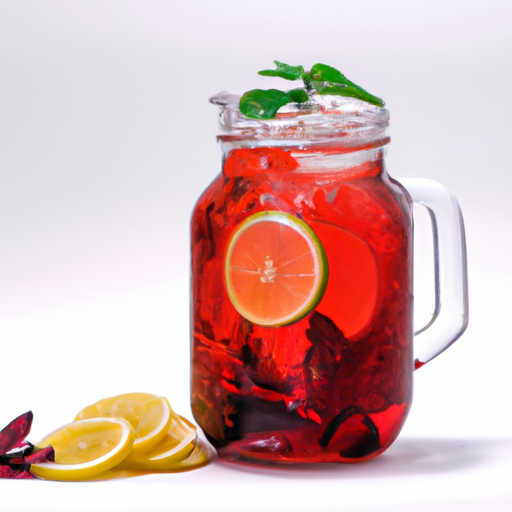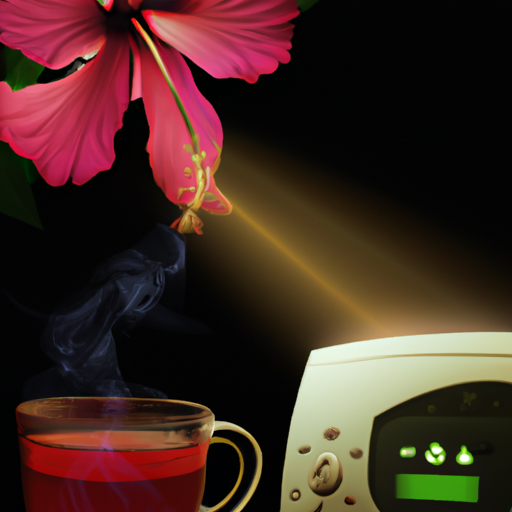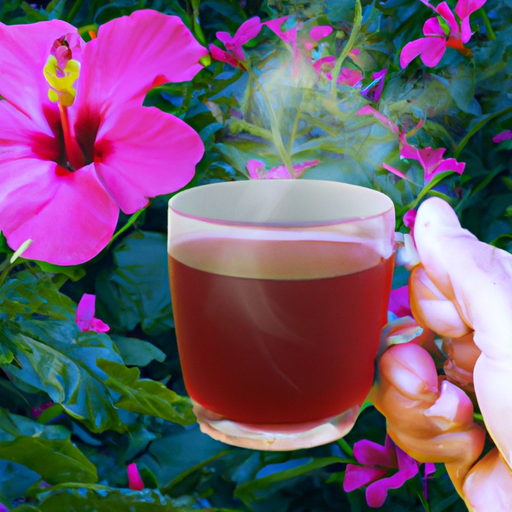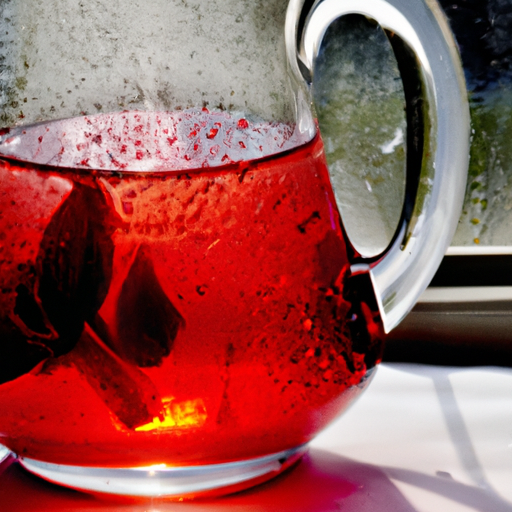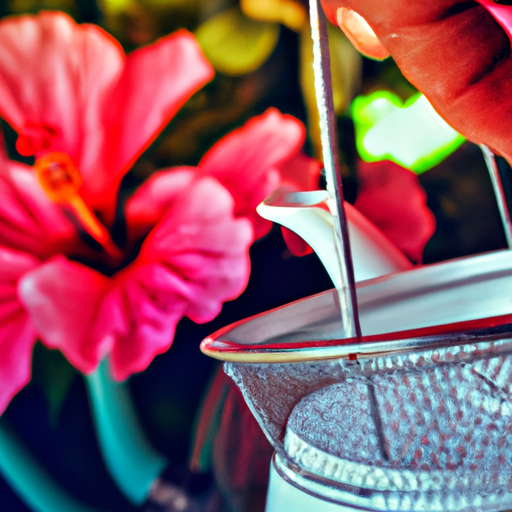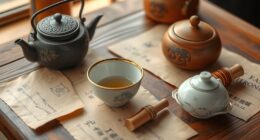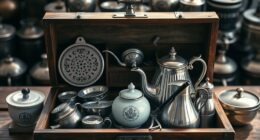While wandering down the aisle at my neighborhood grocery store, my attention was captured by a pack of hibiscus flowers. Their vibrant red hue and distinct form grabbed my attention, compelling me to pick them up.
As I reached for the pack, a fellow shopper beside me exclaimed, ‘You know you can make amazing cold brew hibiscus tea with those!’ Intrigued by this coincidence, I decided to give it a try.
If you’re like me and love exploring different flavors and brewing techniques in your beverages, then cold brew hibiscus tea is definitely worth trying out. Not only is it refreshing during hot summer days but also packed with health benefits.
Hibiscus tea is known to help lower blood pressure and reduce inflammation in the body. Plus, it’s naturally caffeine-free so you can enjoy it anytime without worrying about disrupting your sleep schedule.
In this article, let me guide you through how to make cold brew hibiscus tea at home using just a few simple ingredients and equipment!
Key Takeaways
- Cold brewing hibiscus tea involves steeping hibiscus flowers in cold water for 12-24 hours in the fridge.
- Hibiscus tea is naturally caffeine-free and rich in antioxidants, making it a healthy and refreshing beverage.
- Adding citrus fruits or sweeteners can enhance the flavor profile of hibiscus tea, while herbs and fruits can be used as garnishes.
- Cold brew hibiscus tea should be stored in an airtight container in the refrigerator and consumed within 3 days to maintain its flavor and aroma.
Gather Your Ingredients and Equipment
Ready to get started? Let’s gather all the ingredients and equipment you’ll need for brewing up a delicious batch of cold hibiscus tea!
First, you’ll need some hibiscus flowers. You can find them at your local grocery store or online, either in loose-leaf form or in pre-packaged tea bags. If your store doesn’t carry them, try looking at specialty health food stores or online retailers.
In addition to the flowers, you’ll also need water and a container to brew the tea in. A large glass pitcher is ideal because it won’t react with the acidic tea like metal containers might. If you don’t have a pitcher, any large container with a lid will do. And don’t forget about ice – this tea is meant to be served cold! For those who want a sweeter taste, you can add honey or sugar.
Equipment options include a French press or an infuser basket if you prefer not to strain out the flowers later. However, if you don’t have these on hand, don’t worry; cheesecloth works wonderfully as well. Simply place the desired amount of hibiscus into your brewing vessel and cover with cool water (1 cup per 1 tsp of dried hibiscus).
Now that we have all our ingredients set up, let’s move on to preparing our hibiscus flowers by rinsing them under cool water and removing any debris before starting our brew process.
Prepare Your Hibiscus Flowers
First, you’ll want to pluck the dried hibiscus flowers off their stems, just like picking petals off a flower. Think of it as creating a bouquet of flavor for your drink. Handling these delicate flowers with care ensures that they retain their full flavor and aroma.
Once you have gathered your hibiscus flowers, give them a quick rinse under cold water to remove any dust or debris. Hibiscus tea has numerous health benefits, including aiding in digestion, lowering blood pressure, and boosting the immune system. It’s important to use high-quality hibiscus flowers from reputable brands to ensure that you reap all these benefits.
Some of the best brands for hibiscus flowers include Davidson’s Organics, The Tao of Tea, and Frontier Co-op. After preparing your hibiscus flowers and choosing the right brand for your brew, it’s time to add them to your pitcher. This step is crucial because it sets the foundation for how strong or mild your tea will be.
By following this easy process diligently, you can make delicious cold-brewed hibiscus tea that satisfies both your taste buds and body needs.
Add the Hibiscus Flowers to Your Pitcher
Now it’s time for you to infuse your pitcher with the vibrant and floral essence of your freshly plucked hibiscus flowers, creating a tantalizing aroma that will leave you craving the first sip.
Adding hibiscus flowers to cold water is the foundation of cold brewing tea. You can use a variety of flavor combinations such as lemon, mint or ginger to add depth and dimension to your tea.
Hibiscus tea is not only flavorful but also has health benefits. It’s packed with antioxidants that help fight cell damage caused by free radicals in the body. It can also lower blood pressure and cholesterol levels, making it a healthy beverage choice for those looking to improve their heart health.
By adding hibiscus flowers to your pitcher, you’re not only getting a refreshing drink but also nourishing your body. As you add the hibiscus flowers to your pitcher, make sure they’re fully submerged in water so they can release all their goodness into the brew.
Next up, pour cold water over the flowers and let them steep in the fridge for several hours or overnight. This process allows for slow extraction of flavors from the flowers without any bitterness associated with hot brewing methods.
Pour Cold Water Over the Flowers
You’re about to witness the magic of infusion as you slowly pour water over the hibiscus flowers, unleashing a burst of flavor and aroma that will leave your taste buds tingling with anticipation. Hibiscus tea is not only refreshing but also packed with health benefits such as reducing high blood pressure and fighting inflammation. You can use hibiscus flowers in different ways, from making tea to incorporating them into fruit salads or even making jam.
Pour cold water over the hibiscus flowers until they’re fully submerged. Let it sit for at least 12 hours in the fridge to allow the flavors to fully develop. The longer you steep it, the stronger and more flavorful your hibiscus tea will be.
After steeping, strain out the flowers and discard them. You can now stir the mixture gently before serving over ice with a slice of lemon or lime for added freshness.
The next time you want a refreshing drink that’s both healthy and delicious, try making hibiscus tea using this simple method!
Stir the Mixture
Gently swirl the pitcher, watching as the deep red liquid sloshes against the sides and mixes with the citrusy aroma of fresh lemon. Stirring techniques are crucial when cold brewing hibiscus tea to ensure that every sip is packed with flavor. To stir the mixture properly, use a long spoon or spatula and gently move it around in circular motions. Be sure not to over-stir as this can cause the flowers to break apart and create a cloudy appearance.
Optimal steeping time is also essential when making cold brew hibiscus tea. Unlike traditional hot tea, which requires only a few minutes of steeping time, cold brewing is a slower process that takes several hours. The ideal steeping time for hibiscus tea is between 12-24 hours depending on personal preference. The longer you steep, the stronger and more concentrated the flavor will be.
After stirring your mixture thoroughly, cover and let steep in your refrigerator for up to 24 hours. This will allow all of those delicious flavors to infuse into your tea without any bitterness from overheating or over-steeping. Once your desired steeping time has passed, remove the pitcher from your refrigerator and strain out any remaining flowers using a fine mesh sieve or cheesecloth.
Serve chilled with ice cubes for an invigorating summer drink that’s perfect for any occasion. Stirring techniques and optimal steeping time are critical components when making cold brew hibiscus tea. Take care not to over-stir or over-steep your mixture so that you can enjoy every last drop of its refreshing taste. With these tips in mind, you’ll be able to make a delicious batch of this thirst-quenching beverage at home anytime you want!
Cover and Let Steep
Once the mixture’s been stirred, it’s time to let it sit and steep in the refrigerator. This allows all of the flavors to meld together into a harmonious symphony of taste. The longer it steeps, the more concentrated and flavorful your hibiscus tea will be. I recommend letting it sit for at least 8 hours or overnight.
Aside from its delicious taste, hibiscus tea has numerous health benefits. It’s rich in antioxidants that help fight free radicals in our body. These can cause damage to our cells and lead to diseases such as cancer and heart disease. Hibiscus tea may also lower blood pressure and cholesterol levels, making it a great addition to a healthy diet.
The best time to drink hibiscus tea is up to personal preference. Some people enjoy drinking it in the morning as an alternative to coffee or black tea. Others prefer sipping on it throughout the day or before bedtime due to its calming effect. Whatever time you choose, make sure to strain your cold brewed hibiscus tea before enjoying its refreshing taste and health benefits.
Strain the Tea
To get the most out of your homemade hibiscus drink, it’s important to strain the mixture before serving. This step ensures that any small pieces or debris are removed from the tea and you get a smooth, clean beverage.
There are several straining techniques you can use depending on your preference. One common method is using a fine mesh sieve or cheesecloth. Simply place the sieve over a pitcher, jar or large bowl and pour the tea through it. The sieve will catch any solids while allowing the liquid to flow through.
Alternatively, wrap a piece of cheesecloth around the mouth of a jar or pitcher and secure it with an elastic band. Pour the tea into this makeshift filter and let gravity do its work.
When straining your cold brew hibiscus tea, keep in mind that different methods may affect the flavor of your drink. For example, using a finer mesh will result in less residue but may also remove some desirable particles that contribute to flavor. On the other hand, if you prefer a cleaner taste with no sediment at all, opt for multiple layers of cheesecloth or coffee filters.
Now that your tea has been strained to perfection, it’s time to serve! Whether you enjoy it plain or with added sweeteners like honey or sugar syrup is up to you. In our next section, we’ll talk about how best to serve this refreshing beverage and what garnishes pair well with hibiscus tea!
Serve Your Cold Brew Hibiscus Tea
When serving your homemade hibiscus drink, consider adding a slice of lemon or lime for added flavor and visual appeal. According to a study by the Journal of Food Science, citrus fruits like lemon can enhance the antioxidant properties of hibiscus tea, making it even more beneficial for your health. You can also add some honey or agave syrup to sweeten it up if you prefer a sweeter taste.
Presentation is key when serving any type of beverage. To make your cold brew hibiscus tea look even more appealing, try using clear glassware so that the beautiful red color of the tea is visible. You can also add some fresh mint leaves or edible flowers as a garnish on top. For pairing suggestions, this refreshing drink would go well with light salads, grilled vegetables, and seafood dishes.
Once you have served your cold brew hibiscus tea to your guests or enjoyed it yourself, make sure to store any remaining tea in an airtight container in the refrigerator. It will keep fresh for up to 3 days but should be consumed within that time frame for optimal taste and quality.
In the next section, we’ll discuss how to use any leftover brewed hibiscus flowers for future batches of cold brew tea.
Store Any Remaining Tea
If you have any leftover of this delicious and healthy drink, don’t let it go to waste! Keep it fresh in an airtight container in the refrigerator for up to 3 days, and enjoy every last drop. Remember, every cloud has a silver lining – in this case, you can use any remaining brewed hibiscus flowers for future batches of your favorite beverage.
To ensure that your cold brew hibiscus tea stays fresh longer, store it properly. Make sure to use an airtight container because exposure to air can cause the tea to lose its flavor and aroma quickly. Additionally, keep the container away from direct sunlight or heat sources as they can also alter the taste of the tea.
When experimenting with different variations using your leftover brewed hibiscus flowers, consider flavor pairings that complement its tart and fruity notes. Some popular options include adding citrus fruits like lemon or orange slices, sweetening with honey or agave nectar, or combining with other herbal teas like mint or ginger. Get creative with your combinations and find what works best for you!
Now that you know how to store any remaining cold brew hibiscus tea properly and experiment with different variations using the brewed flowers from previous batches, it’s time to take your brewing expertise up a notch. Let’s dive into some exciting ways to customize your cold brew hibiscus tea!
Experiment with Different Variations
When it comes to cold brewing hibiscus tea, I like to experiment with different variations.
One of my favorite ways to add some extra flavor is by adding fruits or herbs like mint or ginger.
I also enjoy trying different tea combinations, such as mixing hibiscus with green tea or adding a splash of lemon juice for a citrusy twist.
These small additions can make a big difference in the taste and overall experience of enjoying a refreshing glass of iced hibiscus tea.
Adding Fruits or Herbs
To enhance the flavor of your hibiscus tea, try adding slices of fresh fruit and a sprig of mint or basil for a refreshing twist. Not only does this add an extra layer of taste to your drink, but it also provides added health benefits. For example, adding lemon slices can provide vitamin C and aid digestion, while strawberries are rich in antioxidants and anti-inflammatory properties.
Here is a table with some suggested fruit and herb combinations to try in your cold brew hibiscus tea:
| Fruit | Herb |
|---|---|
| Pineapple | Rosemary |
| Watermelon | Thyme |
| Kiwi | Sage |
| Mango | Mint |
| Peach | Basil |
Experimenting with these flavor combinations can take your hibiscus tea experience to the next level. So why not give them a try and see which ones you like best? In the next section, we’ll talk about trying different tea combinations to further expand your taste palate.
Trying Different Tea Combinations
You can take your tea experience to the next level by experimenting with different combinations of teas. Tea pairing is an art that can be learned and enjoyed by anyone who loves tea.
The idea is to combine two or more types of tea to create a unique flavor profile that enhances the taste of each individual tea. Flavor experimentation is key when it comes to trying different tea combinations.
You can start by choosing teas with complementary flavors, such as hibiscus and rosehip, or contrasting flavors, such as green tea and blackberry. Don’t be afraid to mix things up and try something new – you might just discover your new favorite blend!
Remember, there are no rules when it comes to tea pairing, so have fun and let your taste buds guide you on this delicious journey.
Frequently Asked Questions
How long can you store cold brew hibiscus tea in the fridge?
When it comes to storing cold brew hibiscus tea in the fridge, the shelf life can vary depending on a few factors. Generally speaking, you can expect your tea to stay fresh for up to 3-4 days if stored properly in an airtight container.
However, as time passes, the taste of the tea may begin to deteriorate and become less enjoyable. To ensure that your cold brew hibiscus tea stays as fresh as possible for as long as possible, be sure to store it in a clean container and keep it away from any strong-smelling foods or spices that could affect its flavor.
In terms of health benefits, hibiscus tea is known for its high levels of antioxidants and potential ability to lower blood pressure. As for serving suggestions, I recommend pouring over ice with a splash of honey or adding it to sparkling water for a refreshing summer beverage.
Can you add sweeteners to cold brew hibiscus tea while it’s steeping?
Yes, you can definitely add sweeteners to cold brew hibiscus tea while it’s steeping. In fact, adding sweeteners like honey or agave syrup is a great way to balance out the naturally tart flavor of hibiscus tea.
You can also experiment with other flavors and ingredients to create different variations of cold brew hibiscus tea. For instance, adding fresh mint leaves or ginger slices can give your tea a refreshing kick, while cinnamon or cloves can provide warm and spicy notes.
Ultimately, the choice of sweeteners and flavor additions will depend on your personal taste preferences and desired level of complexity in your cold brew hibiscus tea recipe.
What other herbs or fruits can you add to enhance the flavor of cold brew hibiscus tea?
When it comes to enhancing the flavor of hibiscus tea, there are plenty of herbs and fruits that can be paired with it. Hibiscus tea pairings include ginger, mint, lemon, and even berries like strawberries or raspberries.
To infuse these flavors into your cold brew hibiscus tea, simply add a few slices of fresh ginger or a handful of mint leaves to your steeping process. You could also squeeze some lemon juice into the mix or add some berries to give it a sweet twist.
Just keep in mind that when adding extra ingredients to your hibiscus tea, you don’t want to overpower the natural tangy flavor of the hibiscus. So experiment with different herb and fruit combinations until you find one that perfectly complements your taste buds.
How does the taste of cold brew hibiscus tea compare to hot brewed hibiscus tea?
Tasting notes of cold brewed hibiscus tea compared to hot brewed hibiscus tea are quite distinct. The flavor profile of cold brew hibiscus tea is smoother, less tart and astringent as compared to its hot brewed counterpart.
The brewing process releases fewer tannins, which makes the drink more palatable for those who find traditional hot hibiscus tea too bitter or sour. Additionally, the cold-brewed version has a slightly sweeter taste profile that allows for more subtle nuances in the underlying flavors.
It’s important to note that the choice between hot brewed and cold brewed versions ultimately comes down to personal preference, but if you’re looking for a refreshing and less intense option, then cold brewed hibiscus tea may be just what you need.
Can you reuse the hibiscus flowers for a second batch of cold brew tea?
When it comes to second brew options for hibiscus tea, you can definitely reuse the flowers for another batch of cold brew. However, it’s important to note that the flavor and potency of the tea may not be as strong as the first batch.
Despite this, there are still health benefits to be gained from a second brew such as reducing inflammation and aiding digestion. Reusing the flowers can also help reduce waste and save money in the long run.
Just make sure to properly store the used flowers in an airtight container in the refrigerator until ready for use again.
Conclusion
Well, there you have it, folks! I hope this guide has provided you with all the necessary information to brew a perfect cold hibiscus tea at home.
Remember, this refreshing and healthy drink is not only delicious but also packed with numerous health benefits. Did you know that hibiscus tea is rich in antioxidants and can help lower blood pressure? According to a study published in the Journal of Nutrition, consuming hibiscus tea regularly for six weeks can significantly reduce both systolic and diastolic blood pressure levels. So not only does it taste great, but it’s also good for your health!
Now that you know how easy and simple it is to make cold brew hibiscus tea, why not experiment with different variations? Add some fresh mint leaves or ginger slices for an extra kick or try steeping the flowers with other fruits like lemon or orange. The possibilities are endless!
So go ahead and enjoy a glass of homemade cold brew hibiscus tea today!

